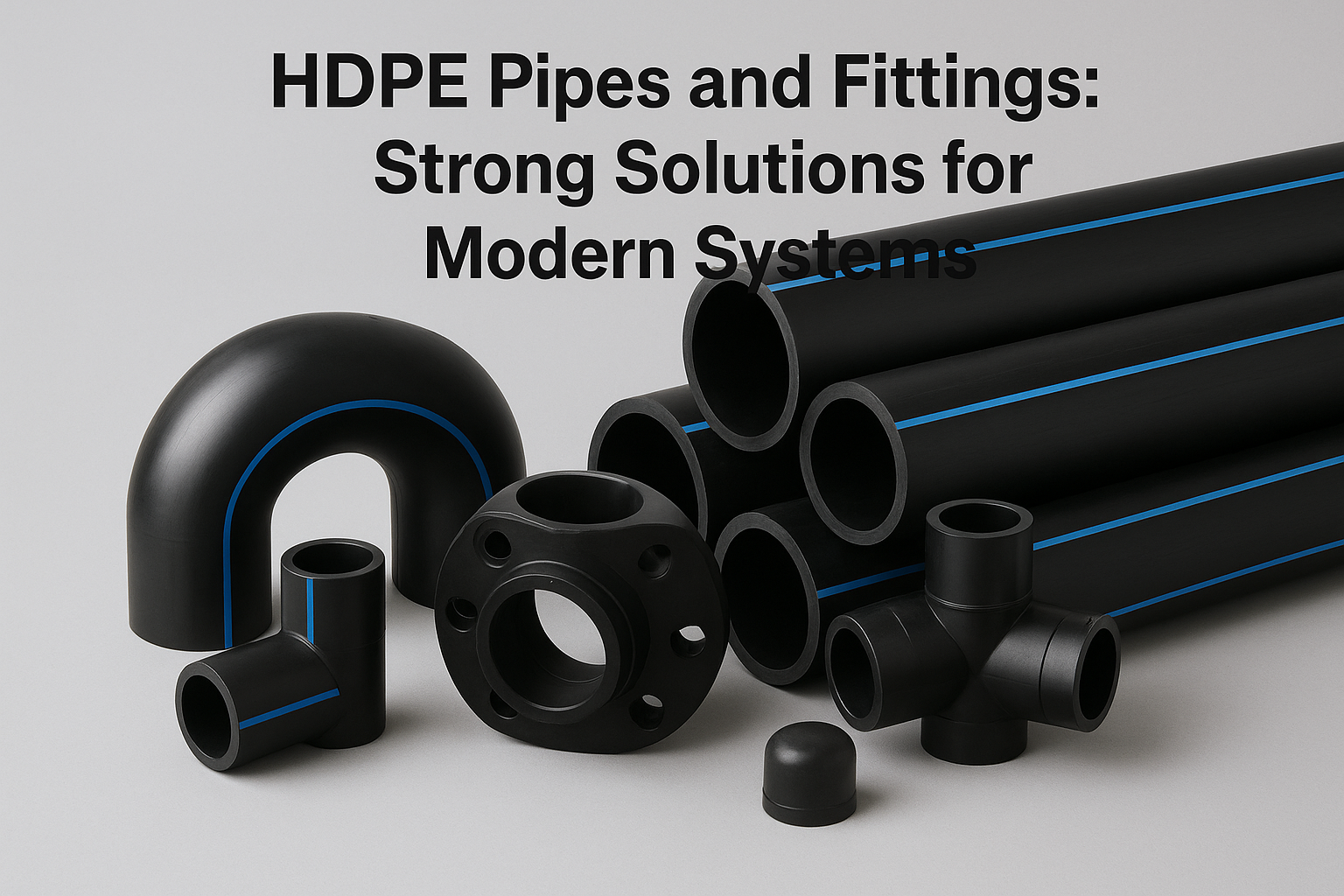In modern construction and infrastructure, materials need to be durable, cost-effective, and versatile. One such material that has transformed industries like water supply, gas distribution, irrigation, and construction is HDPE pipes and fittings. These high-density polyethylene products are known for their toughness, flexibility, and long service life, making them one of the most widely used piping solutions across the globe.
In this article, we’ll look at the properties of HDPE, the wide range of fittings available, and how these systems contribute to safe and reliable networks.
What Makes HDPE Pipes Unique?
HDPE stands for High-Density Polyethylene, a thermoplastic polymer made from petroleum. The material is lightweight yet incredibly strong. It resists corrosion, chemical reactions, and environmental stress. Unlike traditional metal or concrete pipes, HDPE pipes do not rust, crack easily, or react with aggressive substances.
Some standout qualities include:
- Durability: Can last up to 50 years or more with minimal maintenance.
- Flexibility: Ideal for areas prone to ground movement, earthquakes, or shifting soil.
- Leak-free Joints: Heat fusion technology creates seamless connections.
- Chemical Resistance: Withstands acids, alkalis, and various solvents.
These characteristics make HDPE the go-to choice for industries demanding safe and dependable transport of fluids and gases.
Advantages of HDPE Pipes and Fittings
The popularity of HDPE piping systems comes from their long list of benefits:
1. Long Service Life
HDPE pipes can perform for decades without significant wear and tear. They resist internal pressure, UV radiation, and harsh climates.
2. Safety in Fluid Transport
Whether it’s drinking water, sewage, or natural gas, HDPE ensures clean and safe transportation. The material does not leach harmful substances into water or react with carried materials.
3. Cost-Effectiveness
Although initial installation costs may be slightly higher, the low maintenance and fewer repairs make HDPE systems more economical in the long run.
4. Eco-Friendly Choice
HDPE is recyclable and uses less energy during manufacturing compared to metal or cement alternatives. This reduces environmental impact and supports sustainable infrastructure.
Different Types of HDPE Pipes and Fittings
When we talk about HDPE pipes and fittings, we’re not just referring to straight tubes. The system includes a wide variety of components designed to connect, branch, and manage flow in complex networks.
HDPE Pipes
- Pressure Pipes: Used in water supply and gas distribution.
- Corrugated Pipes: Perfect for drainage and stormwater management.
- Irrigation Pipes: Lightweight solutions for agriculture and farming.
- Sewer Pipes: Resistant to chemicals and safe for underground installation.
HDPE Fittings
- Elbows and Bends: Allow direction changes without weakening the line.
- Tees and Crosses: Distribute flow into multiple branches.
- Reducers: Adjust pipe sizes for smooth transitions.
- End Caps and Plugs: Secure pipe ends during maintenance.
- Couplers and Flanges: Join sections safely and tightly.
Applications of HDPE Pipes and Fittings
The versatility of HDPE systems makes them suitable for multiple industries:
- Water Supply Networks: Safe drinking water delivery across cities and rural areas.
- Gas Distribution: Reliable under high pressure, minimizing leaks.
- Agriculture: Irrigation lines, drip systems, and sprinkler networks.
- Mining: Slurry transport due to abrasion resistance.
- Sewage and Drainage: Long-lasting underground networks.
- Telecommunication: Protective casing for fiber optic cables.
These applications show the adaptability of HDPE, from urban infrastructure to industrial projects.
Installation and Maintenance
Installing HDPE pipes involves butt fusion welding, electrofusion, or mechanical joining, which create leak-proof connections. Once installed, the system requires minimal care compared to metal pipelines.
Routine inspections help identify soil movement or external force damage, but the overall maintenance costs remain very low. This is one reason why governments and private companies often choose HDPE for large-scale projects.
Comparing HDPE with Other Materials
Traditional materials like steel, iron, and PVC are still used in piping networks, but HDPE offers several advantages:
- Versus Steel: HDPE does not corrode and is lighter to transport.
- Versus Iron: More flexible and resistant to cracking.
- Versus PVC: Better durability in high-pressure and outdoor conditions.
This balance of strength, flexibility, and longevity positions HDPE as a superior option for modern infrastructure.
Future of HDPE Pipes and Fittings
With the global push toward sustainability, HDPE pipes and fittings are gaining even more attention. Their recyclability, low carbon footprint, and adaptability align with the future needs of smart cities, renewable energy projects, and sustainable agriculture.
Technological improvements in manufacturing will further increase performance, making HDPE one of the most future-ready piping solutions.
Conclusion
From water supply systems to gas pipelines, HDPE pipes and fittings are transforming the way we build and maintain infrastructure. Their durability, flexibility, and eco-friendly profile make them the preferred choice in multiple industries worldwide.
By offering reliable performance and long-term cost savings, HDPE continues to support safe, efficient, and sustainable systems that benefit both communities and the environment.
Visit for more Informational Blogs at writoka.


